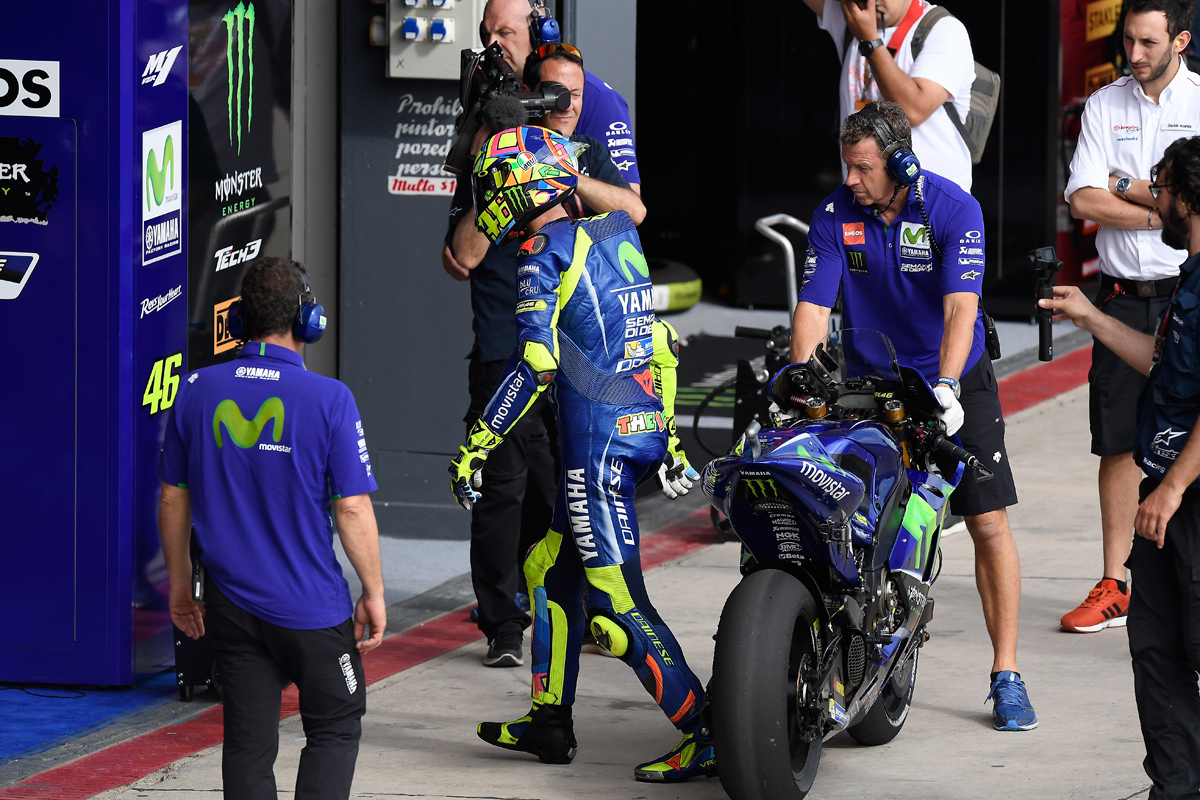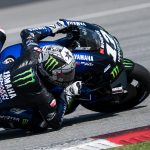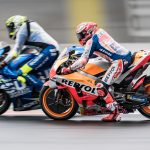When Valentino Rossi crossed the finish line at the Termas De Rio Hondo circuit on Sunday he completed his 350th Grand Prix. That is a truly astonishing statistic: It means he has spent approximately 245 hours, or 10 days and 5 hours of his life aboard a Grand Prix motorcycle. According to the exhaustive and authoritative motorsports database Forix, he has completed a grand total of 37,738 kilometres on 125s, 250s, 500s, and MotoGP machines, 8944 kilometres of which in the lead.
To put that into a more understandable context, here’s what those numbers mean in real terms:
-37,738 kilometres is just 2,337 short of a complete circumference of the earth. In roughly 20 races time, barring crashes or DNFs, Rossi will have racked enough kilometres to have travelled the entire length of the Equator. So at either Jerez, Le Mans or Mugello next year, Rossi will complete a full racing lap of the planet.
-Rossi has spent 8,944 of those 37,738 kilometres leading those races. Put another way, he has spent 23.7% of his racing distance in the lead.
-8,944 kilometres is roughly from his home in Tavullia to Shanghai in China as the crow flies. It is from Tavullia to the Gobi Desert in Mongolia by motorcycle, or all the way from Tavullia to the northernmost point in Europe, the Nordkapp and back, by way of the Nürburgring.
It isn’t just the distances which are mind boggling. Rossi’s 350 Grand Prix starts are more than any other rider in history. Second behind Rossi is Loris Capirossi, with 328, and behind Capirossi, Jack Findlay with a total of 282 starts. (Findlay’s numbers are made more impressive by the fact that he often raced twice on the same day, in the 350 and 500 classes, as was common practice in the 1960s and 1970s.) Rossi’s numbers are all the more remarkable because he has converted so many of those starts into podiums. Of the 350 he has ended up on the podium 223 times (63.7%), and 114 of those times on the top step (32.6%).

But what truly marks Valentino Rossi out from the rest is the fact that he is still competitive at this stage of his career. When Capirossi retired, he hadn’t been on the podium for three seasons, and it had been four years since he had won a race. Rossi’s last win was at Barcelona last year, and his last podium was, well, at his 350th race. He is second in the championship behind his teammate Maverick Viñales, a position he has finished in for the past three seasons in a row.
How does he do it? That is the real mystery behind Rossi’s success. The commitment required to remain competitive is immense at any age, meaning hours of training in the gym, and riding bikes, and pushing to the limit for hour after hour during testing and practice. It means endless hours of frustration waiting around while mechanics and engineers pore over problems, looking for solutions. It means endless hours of even greater frustration wondering why you weren’t as fast as the guy who won. It requires a burning ambition to do anything and everything it takes to win. When you’re 38 years of age, with nine world championship titles, a small warehouse full of silverware, untold millions in the bank, and the pick of any attractive partner of your choice across several continents, what motivation is there?
The will to win, apparently. It is obvious in everything Rossi does that he still loves riding motorcycles, and racing motorcycles, but above all, he loves winning. He consistently refers to “the taste” of winning, something which is profoundly visceral to him, a physical sensation. That feeling is so addictive that many who compete succumb to it, yet Rossi finds a way to stay competitive, to keep winning. Earlier this year, he said he never started each season thinking about winning the championship, but only focusing on each race, and trying to win that. Race by race, he works his way towards a title.
To keep himself fresh, he spends all his time training with the youngsters of the VR46 Riders Academy. By surrounding himself with kids of 16, 18, 20 years of age, he feeds off their energy, and rejuvenates himself. Riding against them he learns the new tricks young riders keep inventing, and adapts his own riding to take on the youngsters who now challenge him. Spanish nobleman Ponce de Leon went searching for the fountain of youth in America, and found Florida. Valentino Rossi found it in his back yard, at The Ranch dirt track facility he had built near his home.
Can Rossi win another title? He faces an uphill task, just as he has done since he returned to Yamaha. The young upstarts who came to supplant him in 2006 and 2008 are now grizzled veterans themselves, and have had younger riders still come to challenge them. New teammate Maverick Viñales has looked invincible since walking into the Movistar Yamaha garage, and Rossi is yet to beat him. Marc Márquez is reigning champion, and will put up a stout defence of his title once Honda sort out the electronics. Dani Pedrosa still lurks in the wings, capable of winning. Jorge Lorenzo may be temporarily incapacitated as he adapts to the Ducati, but if he manages that, will once again be a fearsome foe. Then there are the others, the wildcards, the Cal Crutchlows and Andrea Doviziosos of this world, and who knows how the likes of Johann Zarco and Jonas Folger will develop.
Winning a tenth Grand Prix title is an enormous challenge for Valentino Rossi, and he faces unparalleled obstacles along the way. Despite this, one thing we know. You can never, ever count him out. Nothing is impossible.
Photos by Monster Energy/Milagro








